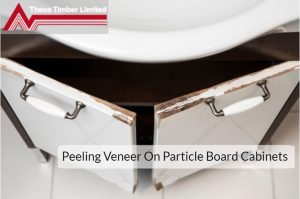Particle cabinet boards are attractive and cost-efficient kitchen cabinet options. In the kitchen, they are subject to a lot of conditions like moisture that could trigger damages. One of the main issues is the peeling of the veneer board. A peeled veneer does not mean that the cabinet has to be gotten rid of. All that needs to happen is repair and better maintenance.
Below are some steps that would come in handy when repairing peeling veneer boards cabinets;

Method 1
The first thing you need to do is to use a pair of pliers to hold back the peeling laminate and apply contact cement under the piece. A paintbrush would come in handy. Make sure the cement comes into contact with the particle board as well. Please make sure the piece of peeling laminae does not get into contact with the cement until it is completely dry.
Once the cement is dry, you can then push the laminate piece on the particleboard and then smooth it. You can either use your hand or a J roller to make sure that there is contact along the piece’s length.
Method 2
You can also clamp the pieces in place as the particle board dries. Depending on where the laminate is located on the board, it might not be possible to clamp the piece. For the pieces that cannot help apart as they dry, you can use a spray adhesive. What you do is push the pieces apart, then spay the product and then push them back together. Use a J roller to smooth them in a place like in the case of contact cement.
Method 3
If the peeled laminate veneers cannot be glued back in place either because they are too damaged or for any other reason, then the solution would get rid of them entirely. In such a case, use a heat gun to loosen the glue that holds the pieces onto the particleboard. This way, you will be able to remove the pieces.
Proceed to measure the replacement veneer depending on the parts of the cabinet where the replacement is needed. Make sure to add a few inches on each side to allow for overhang. Use a circular saw to cut the laminate pieces.
Use contact cement for the replacement of the laminate veneer pieces. Allow the contact cement to dry then place them together. Use a J roller to smooth it out then use a router to trim the edges. Proceed to sand the surface to allow for a smoother finish.
Method 4
This method is targeted towards peeling veneers and not laminate veneers.
It would help if you started by drying the wet particle boards. You can use an air dryer or allow the boards to air dry until all the wetness is non-existent. Once the cabinets are completely dry, you can go ahead and begin the sanding process. Here, you will need medium grit-sandpaper. Sand the cabinet boards until the wet spots vanish. Towards the end of the sanding process, you can use sandpaper with a finer grit. After sanding, you can wipe off all the dust.
After wiping off all the dust, you need to allow the surface to dry again. Depending on the intensity of the wetness, you can either use an air dryer or dry naturally. Once the cabinet board is completely dry, you can proceed to apply a waterproofing agent. Let the agent dry after application.
